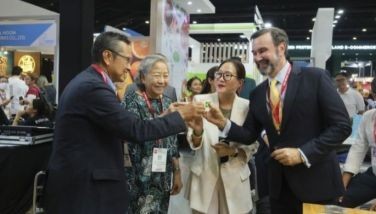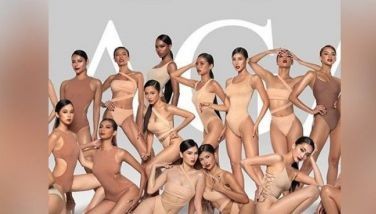Fashion with a cause
July 6, 2003 | 12:00am
 FASHION DESIGN and fashion advocacy are two very different things although ideally they should exist side by side. Ask Lulu Tan Gan, one of the country’s most successful designers. She has bridged the divide between the world of artistic creation and the sphere of fashion advocacy.
FASHION DESIGN and fashion advocacy are two very different things although ideally they should exist side by side. Ask Lulu Tan Gan, one of the country’s most successful designers. She has bridged the divide between the world of artistic creation and the sphere of fashion advocacy.
On July 8, Tan Gan is receiving the Chevalier Award from the French government through the French Embassy in Manila for her achievements in creative design and her efforts in promoting Philippine fashion in France and around the world. For over 10 years, starting in 1992, Tan Gan has been actively organizing the country’s entry to the prestigious Concours International Des Jeunes Createurs de Mode, an annual young designers competition in Paris organized by the Federation Française de la Couture and Air France.
Through the Fashion Design Group (fdg), the Fashion Design Council of the Philippines (fdcp), the Department of Trade and Industry (dti) and the Garment and Textiles Export Board (gteb), the country has been sending young Filipino designers to compete in the Paris exhibition, traditionally held at the Carousel de Louvre, who have brought honor to the country.
"The first time we joined the competition was in 1992 and we brought home the bronze prize for Ariel Alvarez’s entry," Tan Gan says proudly.
This feat was repeated many times over–the grand prize in 1995 for Frederick Peralta’s works, the grand prize in 1998 for Joji Lloren’s entry and the Lessage special award in 1999 for the works of Dong Omaga.
Tan Gan points out that the achievements and the Philippines’ participation in this international gathering is purely for the pride of exhibiting our fashion creations and there is no expectation of commercial return. However, the inspiration is derived from giving young Filipino fashion designers the chance to be recognized the world over and to give them a venue to showcase their works.
"It is in giving them this chance to exhibit their creations side by side with the best in Europe and the world that we give them the opportunity to improve their craft and to aim for something bigger," she stresses.
Tan Gan, a recognized leader in the fashion industry who almost singlehandedly pioneered knitwear as fashion item, is a strong presence in the different design councils that organize these trade shows and fashion exhibitions. She was past president and chairman of fdg from 1986 to 1995 and president of the fdcp from 1995 to 200. She remains as advisory chairperson of the fdcp up to the present. Apart from making a name for herself in the fashion world and basking in the glory of being one of the country’s top designers, she has taken it up as a personal mission to help strengthen the fashion design sector and this, she says, has become the basis of her fashion success.
"I would like to see Manila become the fashion capital in Asia because we have the potential, we have great talents that we could hone to make it big in the region’s fashion industry," she shares.
How long will it take to get there? "Maybe in a generation," she says realistically, "but it takes this generation to start it. Probably if it was done earlier we could have been there by this time. We have to start doing something about it and not just talk about it, so that it will happen in the next generation."
The problem, she says, is that while Manila is such a fashionable place with so many talented designers that cater to a very strong market, we don’t really have a fashion industry to speak of.
"We do have fashion sectors–the fashion designers, the retailers, the manufacturers, the textile millers... but to have an industry we have to put all these together," she explains.
"Our fashion sectors do not really work together as much as they should. Our successful textile millers, for example, export a lot but they hardly supply the domestic market. They are exporting big volumes to the United States and Europe but not really into local production. Meanwhile, our retailers are also importing so much and the designers are into their own ateliers. So there is hardly any interaction. That is why we do not have an industry–but we do have sectors. But if they work together it is easy for the Philippines to be the center of fashion in Asia because we have creative talents," she continues.
As advisory chairperson of the fdcp, Tan Gan has initiated the patnership of the dti and the gteb and the French Embassy’s Cultural Office in Manila to consult and assist the fashion and garment sectors in the country.
The dti itself has been funding the training and the sending of Filipino design entries to Paris and other world competitions since 1998.
"The mentorship program is very important," she stresses, "because we have a lot of talent that is not formally trained in fashion education. You will see that our young designers are very creative in a very raw form. But the subject of entrepreneurship is very important as it leads young professionals a step further in business, marketing and merchandising which is very important in developing the industry."
In 1995, the Center for Trade, Exposition and Mission (citem) and the newly-formed fdcp embarked on the development of the "professional design services" industry. With the support of the dti-citem, Tan Gan started regular short courses taught by American professors from the Fashion Institute of Technology (fit) in New York at the Philippine Trade Training Center on pattern making and draping, merchandizing and design develoment.
From this program, young designers were developed and challenged to compete as the Philippines’ entry to the Concours in Paris, the Makuhari Grand Prix in Tokyo, the Asia Fresh Young Designers Competitions in Osaka and the Asia-Pacific Design Show in Hong Kong.
The process begins with local competitions, and they usually get a lot of entries Cebu, Metro Manila, Davao. From there they choose around 30 designers to go through an intensive mentorship program until the date of the competitions.
Fortunately, she said, there are now schools offering fashion courses, like the University of the Philippines which is offering a Bachelor’s degree in textile or fabric technology, the De La Salle University’s College of St. Benilde, and the Philippine International School of Fashion (pisf), a Canadian fashion school established in the country in 2001.
As a designer, Tan Gan is best known for elegant and timeless knitwear. The "Queen of Knits", as she is fondly referred to in the fashion circle, has an atelier at the Colonnade in Makati City and owns 11 boutiques in three malls and eight boutiques inside department stores. She has also established the Tan Gan De Manille Manufactuing, which is into retailling and exports.
"I specialized in knits because of time limitations," she reveals. "My first job was as a shoe designer in SM Makati. At that time, they didn’t need another dress department so I was placed in the shoe department. But when they opened the designer boutique, they got me as a buyer and merchandizer. After some time I applied as a designer on a part-time basis and that is where I decided to venture into knits."
While knitwear is very popular today, at the time Tan Gan started it wasn’t the case. "So everybody was saying to me: ‘Knitwear? how can you sell that in Manila?’ "
"But I like texture, I like colors and when you are into knits it allows you to design the fabric also. Most designers will start with the material–they will buy in Divisoria or they’ll source somewhere and they will design the garment or the outfit. But with me I will order the yarns and the colors that I want. If you go to my stores you will notice that I have a color story because I can choose my colors. I also create texture," she explains.
"So, I would not complain that there’s not much fabric but I complain about limited yarns. But at least it allows me to create different looks using the same yarns because I can differentiate the texture. But then I constantly have to change my colors," she says.
Tan Gan’s creations has evolved into three sub-labels, TG for the younger market, Tan Gan Women for larger size women and TG Collection for travel and evening wear.
This UST Fine Arts graduate has indeed come a long way but she is still hoping to blaze yet more trails for the country’s fashion and garments sector.
While she no longer heads the fdcp, she is confident of the programs continuing under the presidency of Randy Ortiz. "He will continue the program of collaborating with the textile millers and garment manufacturers, the young designers and retailers," she says, adding, "We all have to move on."
BrandSpace Articles
<
>
- Latest
- Trending
Trending
Latest
Trending
Latest
Recommended


















